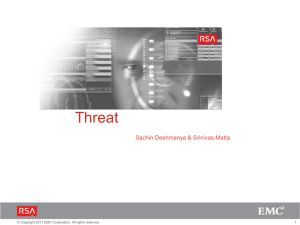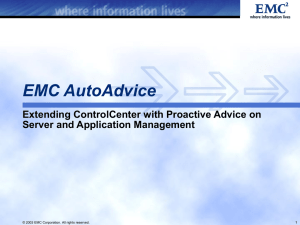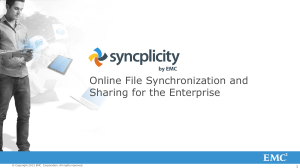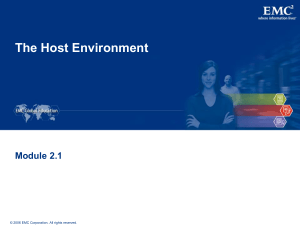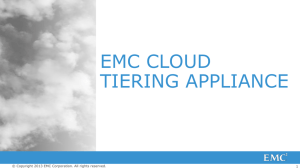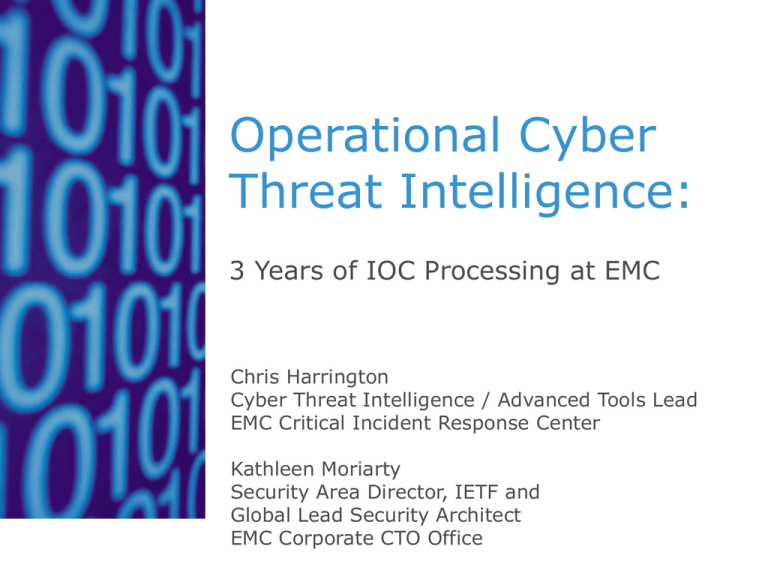
Operational Cyber
Threat Intelligence:
3 Years of IOC Processing at EMC
Chris Harrington
Cyber Threat Intelligence / Advanced Tools Lead
EMC Critical Incident Response Center
Kathleen Moriarty
Security Area Director, IETF and
Global Lead Security Architect
EMC Corporate CTO Office
Agenda
Lessons learned from 3+ years @ EMC
Efficient and Effective Information Exchanges
Transport Options for Data Exchanges
IETF Update, transforming security
How can I participate in the IETF?
– End Users, Developers, Implementers, Vendors,
etc.
EMC CIRC
• Critical Incident Response Center
– Staffed 24x7
– Locations in Massachusetts and Bangalore
– 25 full time employees split across 5 teams
•
•
•
•
•
CIRT
CAT
ATTA
CTI
Security Sciences
© Copyright 2012 EMC Corporation. All rights reserved.
3
Incident Response @ EMC
• 50,000 Employees
• 20,000+ contractors
• 500+ locations in over 80 countries
• 8 Internet gateways
• 250,000+ endpoints
Never a shortage of “interesting” things
© Copyright 2012 EMC Corporation. All rights reserved.
4
Flashback to March, 2011
• RSA had a security issue
– You may have heard about it
• CIRC was fewer than 10 people, not 24x7
• Post- breach analysis indicated that
“Threat Intelligence would have played a
major role in detecting this activity.”
© Copyright 2012 EMC Corporation. All rights reserved.
5
So what did we do?
• Built a full time CyberThreat Intelligence
group
– 2.5 FTE’s
• Bought multiple intelligence feeds
• Joined multiple threat sharing groups
• Custom developed a Threat Intel portal / DB
• Developed own in house OSINT gathering
© Copyright 2012 EMC Corporation. All rights reserved.
6
Threat Intel: 0 to 100
So what happened???
© Copyright 2012 EMC Corporation. All rights reserved.
7
Observed Threat Intel Issues
• Some Threat Intel vendors don’t understand
the difference, Intelligence vs. Information.
– Here is a “bad” IP with no context as to why it’s
bad
– Needs to be actionable to be Intelligence
Result: Resources wasted on false positives
Result: Resources wasted researching
© Copyright 2012 EMC Corporation. All rights reserved.
8
Observed Threat Intel Issues
• Lack of widely adopted standard for sharing
Threat Intelligence or IoCs
– STIX, IODEF, OpenIOC all have Limited vendor
adoption
Result: Resources wasted on logging into
various portals, maliling lists, feeds, etc.
Result: Human errors when transferring data
© Copyright 2012 EMC Corporation. All rights reserved.
9
Observed Threat Intel Issues
• Limited platforms / applications for Threat
Intel
– Sharing, reviewing / approving, integration,
“retiring”
– Have you every retired an IoC?
– How big are your block lists?
Result: IoC lifecycle management very difficult.
Result: Increased impact on security controls
© Copyright 2012 EMC Corporation. All rights reserved.
10
Observed Threat Intel Issues
– Quality of product from vendors varies
• Some do a good job of vetting indicators
• However we still see 8.8.8.8 listed as bad
Result: Impact to operations
• I blocked Salesforce.com for 30 minutes
Result: Custom tools to vett intelligence / IoCs
© Copyright 2012 EMC Corporation. All rights reserved.
11
Observed Threat Intel Issues
• Justifying the expense to management
– Lack of obvious “wins”
– Early failures due to poor 3rd party intelligence
– Still not finding “all the bad stuff”
– A lot of custom development
© Copyright 2012 EMC Corporation. All rights reserved.
12
What did we do?
• Reviewed Threat Intel sources
– Removed those that fail to provide context
– Taking a hard look at those who don’t provide
structured IoC delivery, regardless of context
– Understand each vendors focus areas.
• Do you need Cybercrime Intel or just APT?
• Migrated from custom Portal to CRiTS
– Still requires substantial code changes to support
EMC workflow
– Developing capability to integrate with multiple
sharing standards
© Copyright 2012 EMC Corporation. All rights reserved.
13
What is next? Efficiency
• Tracking incident false positive rate based
on Threat Intelligence source
– Assign confidence values to sources
– Feedback to source vendor
• Correlating alerts across multiple data
sources to add contextual elements to
Incident record
– When alert from DNS fires check proxy /
firewall logs for contextual data and add to
Incident
© Copyright 2012 EMC Corporation. All rights reserved.
14
What is next? Harvesting IoCs
• Malware Intelligence Program
– Leverages Yara, VirusTotal, Cuckoo, Internal
DB
– Search for new samples of specific Threat
Actor tools each night and programmatically
extract IoCs
• Passive DNS
– Internally generated and commercial
– Used to pivot on known IoCs to find more
© Copyright 2012 EMC Corporation. All rights reserved.
15
Lessons Learned
• Threat Intel quality varies widely
– Get some samples before signing the contract
– Ask your peers
• Threat Intel requires manual data entry
– Amount is proportional to # of sources
– This is improving, more support for standards
• Threat Intel will likely require custom coding
– Portal/DB, workflow integration, federation/sharing
© Copyright 2012 EMC Corporation. All rights reserved.
16
Lessons Learned
• Organizational Maturity required
– Threat Intel isn’t the silver bullet
• Need to manage expectations
– Expensive
• Both in $$$ and human capital
– Requires constant care and feeding
• New vendor offerings, quality of data
– Doesn’t always produce tangible results
• No hits today. Intel failure or nothing going on?
© Copyright 2012 EMC Corporation. All rights reserved.
17
Efficient &
Effective
Exchanges
© Copyright 2012 EMC Corporation. All rights reserved.
18
Pervasive Monitoring Call to Action:
What kind of Internet does society want?
– Vulnerable to Attacks or
– Secure for all users?
– Bruce Schneier
My question to you: How will the FIRST community
respond?
© Copyright 2012 EMC Corporation. All rights reserved.
19
Who is Sharing Data? What is Useful?
•Deploying security technologies with expectation of threat mitigation
Small &
Medium
Organizations
Increasing
Impact
Potential!
Large
Organizations
Hidden from user
•Deploying security technologies with expectation of threat mitigation
•Participating in multiple sharing groups
•Receiving multiple threat intelligence feeds
Hidden & Exposed to User
•Analysis for industry focused or other sharing groups
•National CSIRTs providing information to government, critical infrastructure,
etc.
•Internet Service Providers performing analysis, eliminating/mitigating threats
Analysis Center •Problem specific analysis groups targeting focused threats (analysis &
mitigation)
Use case/user group specific
IODEF/RID
Evolved
by problem
owner, mayOpenIOC
include
ARF
eCrime
multiple complimentary
schemas
Extensions
Malware
STIX
Etc. or
ones specific to the problem.
© Copyright 2012 EMC Corporation. All rights reserved.
20
Use Case Driven Adoption
One Size Does Not Fit All
Law
Enforcement
Small & Medium
Organizations
Proprietary
Vendors
OpenIOC
VERIS
CSV
Consortiums/
Alliances
Large
Organizations
CIF
Operators
IODEF/ RID
STIX/TAXII
ISACs
• Shared threat intelligence must be:
– Directed: Intelligence received must be relevant to the
organization
– Actionable: Intelligence must identify an immediate and active
security response that mitigates the risk
– Automated: Remediation based on intelligence must NOT impact
the user experience
© Copyright 2012 EMC Corporation. All rights reserved.
21
Achieving Interoperability
Rough Consensus and Running Code - Interoperability
Simplicity
– “Complexity is the Enemy of Security”
– Options often eliminated to achieve interoperability
Re-use
– Determine requirements and evaluate appropriate solutions
– Use existing protocols where appropriate
Reviews
– Find problems that prevent interoperability
– Working group experts in specific problem set
– Area specific reviews:
▪ Security, Transport, Routing, Application (internationalization,
XML, etc.), General
© Copyright 2012 EMC Corporation. All rights reserved.
22
Transport Requirements
Exchange of structured data formats
End-to-end encryption
Access controls
Publish/subscribe
Federation
Integration with existing tools
Interoperability between implementations
– Reduce options, ideally do what makes sense to meet requirements
– Consider long term support and maintenance of specification or standard and open
source implementations
– Availability of open source implementations
Transport should not be specific to a data format
Flexible for multiple types of connections
– Point-to-point
– Multi-point
© Copyright 2012 EMC Corporation. All rights reserved.
23
Transport Options
Transport
Option
Protocol
Intended Use
RID
HTTP/TLS
High-Security,
Point-to-Point
•
High-security level
provided
•
Doesn’t scale, protocol and
design more appropriate
for Point-to-point
TAXII
HTTP or
HTTPS
“Preferred
transport for
STIX” for all
connections:
Point-to-point,
Hub-n-spoke, etc.
•
Publish/subscribe
supported through
TAXII services
Large number of
features
•
Complex, plan includes
support for multiple
protocols & “services”,
leads to interop challenges
HTTP SOAP-like
architecture not best fit for
features/services provided
(federation,
publish/subscribe)
Option for clear text
transport
Determine Best Fit
Pros
•
Cons
•
•
ROLIE
XMPP
REST
HTTP/TLS
Internal
networks, trusted
partner, or open
access
•
•
XMPP
Good for complex
environments.
•
•
•
•
© Copyright 2012 EMC Corporation. All rights reserved.
Enables search
Secure access
controls by user/role
•
Proven scalability and
interoperability
Integrated in incident
response tools
Federation
Publish/subscribe
•
•
Encryption of data at rest
difficult
Push model preferred for
emergency notifications
OTR used for end-to-end
encryption, more robust
solution in development
24
Open Source Implementations
Transport options
RID Implementations:
– http://tools.ietf.org/html/draft-moriarty-mileimplementreport-00
– http://siis.realmv6.org/implementations/
TAXII Open Source Implementations:
– https://github.com/TAXIIProject
– See also: https://taxii.mitre.org/
ROLIE Implementations: None
XMPP Open Source Implementations:
– http://xmpp.org/xmpp-software/servers/
– *Numerous interoperable open source implementations!
© Copyright 2012 EMC Corporation. All rights reserved.
25
Related IETF
Working
Groups
© Copyright 2012 EMC Corporation. All rights reserved.
26
IETF’s MILE
MILE Overview
– http://trac.tools.ietf.org/wg/mile/trac/
Charter:
– http://datatracker.ietf.org/wg/mile/charter/
Current list of drafts:
– http://datatracker.ietf.org/wg/mile/
▪
▪
▪
▪
▪
▪
RFC5070-bis
IODEF Enumeration Reference Format
IODEF Guidance
RESTful indicator exchange using IODEF/RID
Cyber physical extension
PLASMA for improved security
MILE
Decisions for Transport
Why does RID provide publish/subscribe?
– Not a good fit for HTTP protocol, already available in XMPP
Why doesn’t RID have a robust query capability?
– Not a good fit for HTTP
– Puts onus of query on receiver, preferred method was search provided
in ROLIE (RESTful architecture)
Does RID support hub-n-spoke?
– Yes, but XMPP’s federation capabilities are superior and well tested,
providing a more flexible option
Implementation support
– XMPP has hundreds of interoperable implementations
– Well tested and already used by incident responders
– RID also has multiple interoperable implementations, but is not
intended for wide-scale deployments that XMPP could better support
© Copyright 2012 EMC Corporation. All rights reserved.
28
Security Automation & Continuous
Monitoring (SACM)
Your help is needed on draft reviews and submissions!
Why should I care about SACM?
– With automated security management, vulnerabilities and
exposure risks could be identified and eliminated faster. This
leaves us with less information to exchange on indicators and
incidents.
– Get to the root of the problem: Secure your infrastructure!
SACM Overview & Charter
– http://datatracker.ietf.org/wg/sacm/charter/
SACM Drafts:
– http://datatracker.ietf.org/wg/sacm/
▪
▪
▪
▪
▪
SACM
SACM
SACM
SACM
SACM
Terminology
Use Cases
Requirements
Telecom Requirements
TNC Architecture
© Copyright 2012 EMC Corporation. All rights reserved.
29
Extensible Messaging and Presence
Protocol (XMPP)
Why not use one protocol? – XMPP
XMPP Overview and Charter
– http://datatracker.ietf.org/wg/xmpp/charter/
– Additional information: http://xmpp.org/
XMPP Documents:
– http://datatracker.ietf.org/wg/xmpp/
– Reviews needed from YOU on end-to-end encryption:
– https://datatracker.ietf.org/doc/draft-miller-xmpp-e2e/
© Copyright 2012 EMC Corporation. All rights reserved.
30
IETF
Security
Update
© Copyright 2012 EMC Corporation. All rights reserved.
31
IETF (Re)Action to Pervasive Monitoring
Overall: snowdonia has re-energised folks to do
better on security and privacy in general (and
not solely in response to PM)
–
–
–
–
–
Side meeting in Berlin @ IETF-87
Tech plenary, major discussion @ IETF-88
STRINT workshop before IETF-89
Topic at many meetings/BoFs @ IETF-89
Wanting to see results from IETF-90 onwards…
Unsurprisingly this is similar to the more broad
technical community reaction
See Stephen Farrell’s talk from Terena May 2014
– This slide and the following slides were derived from:
▪ https://tnc2014.terena.org/core/presentation/83
© Copyright 2012 EMC Corporation. All rights reserved.
32
Opportunistic Security
IETF security work has IMO tried to gold-plate key management too
much
– Only ~30% of web sites doing any form of TLS after 20 years
Opportunistic security provides a way to get much easier deployment
for some intermediate level of security
– Not plaintext (but might fall-back)
– Endpoints may or may not be one-way (think TLS server-auth), mutually, or
just not authenticated
– FB stats reporting 58% of MTA-MTA mail using STARTTLS with about half of
that being “opportunistic” and half with a strictly authenticated endpoint
▪
https://www.facebook.com/notes/1453015901605223
Terminology debate:
– Opportunistic encryption → Opportunistic Keying → Opportunistic Security
– Happening on saag list, hoping to finish soon with informational RFC
– draft-kent-opportunistic-security is getting close, another simpler approach in
list email from Viktor Dukhnovni
Bogus argument: that could give a false sense of security!!!
– Protocols do not give any sense of security, implementations (with UI) do
– Ask your browser/web-server-config s/w authors about that one, not the IETF
© Copyright 2012 EMC Corporation. All rights reserved.
33
New IETF Work Related to Pervasive
Monitoring (PM)
“Pervasive Monitoring Is an Attack”
– RFC7258/BCP188 published after major IETF LC
debate – sets the basis for further actions
– https://www.rfc-editor.org/rfc/rfc7258.txt
– BCP says to consider PM in IETF work
Old-RFC privacy/PM review team formed
– Please help! Mail Security ADs – secads@tools.ietf.org .
IAB re-factoring security and privacy
programs into one
© Copyright 2012 EMC Corporation. All rights reserved.
34
IETF Work related to PM
Using TLS is Applications (UTA WG)
– Update old RFCs on how to use TLS in applications and mandate
implementation of non-PFS ciphersuites
– Generic BCP for TLS ciphersuites
TLS 1.3 (TLS WG)
– TLS 1.3 being developed aiming for better handshake performance and
encryption properties
– And learning from our history of previous TLS problems
HTTP/2.0 (HTTPBIS WG)
– Major deployment model: HTTP over TLS
– Significant debate: concept of http: URIs being accessed via TLS (alt-svc), with
no browser indication that crypto is happening
– Debate on requiring server auth
TCP Increased Security (TCPInc)
– Provide TLS functionality within TCP
– Support Opportunistic security with a way to hook in authentication
DNS Privacy
– Reducing exposure of sensitive names found in DNS
▪
https://datatracker.ietf.org/doc/draft-bortzmeyer-dnsop-dns-privacy/
© Copyright 2012 EMC Corporation. All rights reserved.
35
How Can I help?
Participate in the IETF working groups:
– Volunteer Driven
▪ RFCs can be updated as needed, with or without a working group in future
– Meetings are held three times a year
▪ Meeting dates/times can be found at: http://www.ietf.org
▪ Participation can be in person or remote via MeetEcho
▪ All decisions are finalized on the mailing list
– Join working group mailing list, for example: MILE@ietf.org
▪ Participate in an existing thread
▪ Start a thread on any questions based on review of a draft
▪ Start a thread on work to be proposed related to MILE
Review background information on working groups including
implementation information:
– List of working groups: http://datatracker.ietf.org/wg/
Contribute to open source code implementing standards
Provide feedback on code and associated RFCs and drafts
– Join the Privacy/PM Review team: ietf-privacy@ietf.org
– Or submit a ticket with your review information:
https://trac.tools.ietf.org/group/ppm-legacy-review/wiki
Thank you!

